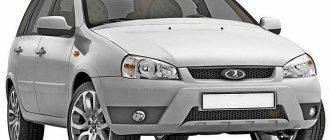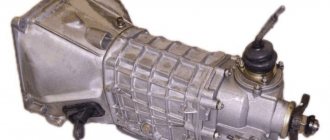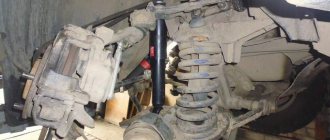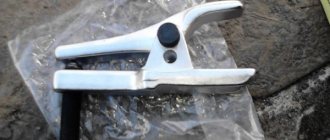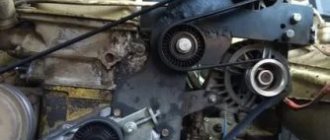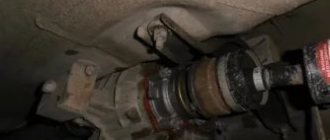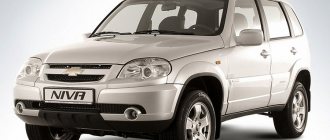Chevrolet Niva permanent all-wheel drive or not
Chevy Niva is a working car that performs its functions 100%, whether in the city, in the countryside or even off-road.
Winter, with all its delights, makes the Chevy Niva especially proud, like a real SUV. After all, not many cars have PERMANENT ALL-wheel drive
, but Niva’s is really constant.
Although there is an opinion that it only has drive on one wheel - the rear right one! Don't believe me? And you jack it up (a word not from the vocabulary of blondes) to hang this wheel and put the car into gear with the car running. Only the hanging wheel will spin! Well, actually, be glad that it’s not a spare ;))))
By the way, if you turn on the center lock
, then you will be able to jump off the jack, so Shniva is definitely a cool SUV! %)
Have you locked it? Did you move off the jack? Disable the blocking! Doesn't turn off? Does the transfer lever not want to pull to the right? Why did they stick it in? So just drive now. It’s okay that the tires around the city will quickly be consumed, but the drive is not on one wheel, which means you won’t get stuck! %) Okay, I’ll give you a hint... in reverse with the steering wheel turned in an arc, roll the car slowly about 5 km/h - then pull the lever to the right! This is mechanics, and not some Haldexshmaldex electron-viscous couplings!
Shnivy also has a low gear
— this is the transfer case lever forward if you move it. don't be afraid! From lower it easily switches back ;). The lowering is specifically designed to dig into the snow or sand at full throttle, and then get out of it, to show that this is not just a station wagon with increased ground clearance, but an SUV that digs itself in and then gets out of the trench!
Homework
: Name 5 mass-produced cars with permanent all-wheel drive.
The Niva car became the first Soviet SUV to use an all-wheel drive transmission. A characteristic feature of the car is the center differential locking mechanism. There is an opinion among motorists that this mechanism serves to connect the front axle. However, the front-wheel drive Niva is always connected. You can figure out what drive the Niva has after studying the design of this unit.
Features and malfunctions of the transfer case
The Chevrolet Niva transfer case not only moved back by 250 mm, but also changed the installation angle by 4 degrees. Chevrolet engineers calculated that this angle would be optimal for the operation of driveshaft joints. The design of the transfer case uses small-module, low-noise gears, so the howling of the transfer case, as on the old Niva, is now completely eliminated.
Another common malfunction of the transfer case on old Nivas was vibration. On Chevrolet, this issue has been practically resolved by installing new pillows and the appearance of a third attachment point. This will eliminate not only operational vibrations and noise, but also the likelihood of incorrect installation of the transfer case after repair, prevention or troubleshooting.
There is another malfunction that few people think about, however, this problem is related to the resource and endurance of constant velocity joints. The fact is that a cermet valve is installed directly under the CV joint boot mounting clamp. Its task is to compensate for excess pressure inside the cover, thereby protecting it from rupture, and the CV joint itself from water and dirt. If you monitor the performance of the cermet valve during repairs or replacement of hinges, the boot will last a long time and will reliably protect the CV joint.
The Niva car became the first Soviet SUV to use an all-wheel drive transmission. A characteristic feature of the car is the center differential locking mechanism. There is an opinion among motorists that this mechanism serves to connect the front axle. However, the front-wheel drive Niva is always connected. You can figure out what drive the Niva has after studying the design of this unit.
Niva drive device
The chassis of the car is made on the principle of permanent all-wheel drive - torque from the power unit is transmitted to all 4 wheels. This scheme improves the performance of the car when driving in off-road conditions, while simultaneously reducing the load on transmission parts.
The Chevrolet Niva drive consists of the following components:
- Gearbox.
- Transfer case.
- A pair of drive and cardan shafts.
- Front and rear axle gearboxes.
The transfer case is designed to distribute torque between the drive axles of the vehicle. The car is equipped with a two-speed transfer case, which provides:
- stable running of the machine when driving at low speed and at high engine speeds;
- power distribution between drive axles, depending on road grip.
The differential is one of the most important elements of the transmission. Its main purpose is to distribute traction force, and, if necessary, ensure rotation of two consumers at different angular speeds. The Chevrolet Niva drive transmission has three differentials:
- One for each axle (inter-wheel) - they allow the wheels of the same axle to rotate at different speeds.
- The third (interaxle action) - transmits power from the power unit to both axles of the vehicle. It also allows the shafts to operate at different angular speeds, depending on operating conditions, which significantly improves controllability.
A pair of cardan shafts (CV joint or cross design) provide connection between the transfer case and the drive axle gearboxes. Both car shafts have the same design - they are interchangeable.
The front and rear axles transmit force from the transfer case to the drive wheels through external and internal angular velocity joints.
Niva transmission how to operate correctly: operating principle
The VAZ 2121, in other words, “Niva”, entered mass production in the 70s of the last century. This car belongs to the class of off-road passenger cars. In the history of the domestic automobile industry, Niva became the first car whose design used all-wheel drive. Let's take a closer look at the transmission device. This should be done in order to understand why, given its almost 40-year history, the Niva transmission differs from many other similar vehicles equipped with all-wheel drive and the ability to shift in the classical way or using a viscous coupling.
The transmission in the Niva family (2121, 2131) is designed in such a way that all-wheel drive is supplied to 4 wheels. Also characteristic is the presence of a center differential. The transmission includes a gearbox, a transfer mechanism, a pair of cardan shafts, and both axles. A characteristic feature of the 2131 model is its elongated body. Otherwise, the main similarities with the first model can be traced throughout. Torque is transmitted from the engine through the gearbox to the transfer case, and it, in turn, transmits torque to the axles.
Then it goes through the cardan shafts to the gearboxes. The front gearbox transmits torque to the wheels through the differential and constant velocity joints. Likewise for the rear, also protruding, driving wheels. It is precisely because the torque is distributed to 4 wheels simultaneously that the drive is called full drive. The designation is as follows – 4WD. Another domestic car, designed on a similar principle to the Niva, is the UAZ.
Differential
This mechanism is a kind of distributor of traction forces coming from the motor to the wheels. An important feature is that the latter have the ability to rotate at different speeds. The importance of having a differential mechanism is due to the fact that during turning maneuvers, the wheel located inside makes fewer revolutions when compared with the number of turns of the outer wheel.
In the absence of a differential mechanism, this would cause detrimental consequences, such as wear and damage, because the result would be the following: when turning, one wheel would be in a slip state, and the second would simply rub against the road surface. The design features of the Niva transmission provide for the presence of 3 differentials. They are located in each of the bridges and in the transfer mechanism.
When the car moves on a flat road and in a straight line with differentials, the traction force is divided equally between all 4 wheels. If there is insufficient adhesion of the wheels to the surface or slipping occurs, the differentials will redistribute the load on the slipping and sliding wheel so that the first receives more force, and the second, accordingly, less.
We have already mentioned UAZ. Despite many similarities, it should be understood that the VAZ’s all-wheel drive is made in the “pat-time” style. This means that when connected, the axes are firmly connected to each other, and rotation occurs at the same speeds. This device imposes some restrictions on the use of all-wheel drive - it can only be used in cases where road conditions allow slipping. In cases with hard asphalt roads and highways, it is recommended to switch the car to single-drive mode.
Differential locking
Sometimes you can come across a misconception about why a small handle is needed next to the shift lever on a Niva. Some car owners believe that it is needed to connect front-wheel drive. However, the front-wheel drive of this car is permanently connected. As is the rear one. Cars of the Niva family have permanent all-wheel drive. The handle actually serves to switch the operating modes of the differential of the transfer mechanism.
In the “forward” position, the differential operates as usual, but if you move it back, the differential is locked, and the forces from the motor are applied to the differentials of the axles, which makes the drive more rigid. It is worth noting that there are also special types of locks for front and rear axles.
In theory, when used in conditions where the car is stuck, it will be able to overcome the obstacle if there is sufficient traction on at least one wheel. In this case, it is better to lock the differential before overcoming an obstacle, but never after entering an area that is difficult to overcome. This application of locking will avoid wear and damage to the transmission.
A series of downshifts
You can often encounter the following type of misconception: switching the rear handle can increase the power characteristics of the motor. But this is not true. It serves to change the gear ratio between the engine and the wheels. By increasing it, the traction forces on the wheels will increase. There is also a reduction gear in the dispensing mechanism.
The principle of operation of all-wheel drive on a Chevrolet Niva
In normal mode, the Chevrolet Niva operates in high gear with the differential unlocked. Torque is transmitted from the power unit, through the gearbox and intermediate shaft, to a two-stage transfer case gearbox. A center differential is installed in the transfer case housing. It links the front and rear axles, allowing them to rotate at different speeds, depending on road conditions and direction of travel.
How does all-wheel drive work on a Niva with a locked differential?
When all-wheel drive is engaged, both cardan shafts are secured with a locking clutch. This promotes uniform transmission of traction force to both axles of the vehicle. Due to this, the vehicle's cross-country ability increases, but controllability deteriorates.
Advice: It is not recommended to use the lock mode on roads with good grip, as this will lead to accelerated tire wear, increased load on transmission parts and components, and will also increase fuel consumption.
Gearbox and clutch Niva Chevrolet
The Niva has virtually the same VAZ gearbox, but with minor changes designed to increase the durability of the unit. Firstly, this is the replacement of the VAZ rear bearings of the primary shafts and intermediate bearings on the secondary shafts with similar, but sealed types. This eliminates bearing malfunctions associated with contamination and premature wear. Secondly, the gear shift control drive has been changed. It is easy to notice that in a Chevrolet the gearbox control lever is closer to the driver, which makes control more convenient. This was achieved through the use of an extension with a 250 mm horizontal rod. Gear ratios remain the same, as does the gear shift pattern.
How to turn on all-wheel drive
Since the drive on the Niva is constantly all-wheel drive, the question of how to turn on the all-wheel drive on the Niva Chevrolet means how to turn on the center differential lock.
You need to use blocking in the following cases:
- when driving in difficult terrain where there is a danger of wheel slipping;
- when there is a lack of engine thrust;
- when driving on a road covered with snow or ice.
Important: Blocking is useless when the car is hung diagonally, when one wheel on different axles begins to slip. This is due to the design feature of the transmission. In this case, you need to act according to the situation - dig up or pour under the hanging wheels.
The main component of the axle locking mechanism is the transfer case. The transfer case is controlled by one six-position lever. The longitudinal stroke provides higher and lower gear rows. Transverse - responsible for locking the center differential. When the lever is in lock mode, a yellow icon lights up on the instrument panel. There are no synchronizers in the design of the transfer case, therefore, when you try to engage the speed range or lock, the gears clash tooth to tooth. To switch, you just need to move the car forward or backward and then everything will switch.
Suspension lifting Niva VAZ 2121 21213 21214 2131
When a person buys a Chevrolet Niva, he rarely thinks about an extreme trip. Most often, a car is bought for a picnic with the whole family. That is, the car moves from one point to another.
Although the Chevrolet Niva is an SUV, it is noticeably inferior to its European and Asian competitors in cross-country ability in hard-to-reach places. It is because of this problem that fans of hunting, fishing and simply extreme driving choose to lift their car instead of watching videos while sitting at home.
Lifting is a type of tuning that increases the vehicle's ground clearance. They often do it with their own hands, in garages.
Chevrolet Niva
Proper modification will turn the Niva into a fairly solid car that will show excellent results off-road and in difficult terrain. We mentioned the word “lifting”, but did not say what it is.
Lifting is a set of changes made to the design of the car. They allow you to install larger diameter wheels on your car. Most often, cars with all-wheel drive are chosen to create such projects.
An all-wheel drive jeep is much more suitable for this task than a simple passenger car.
Read news about the new Niva
- All about the Valet button and how to disable it yourself on alarm systems of different brands
- Niva Lynx buy in Samara - prices for the new Lada “Bronto” (Niva Pickup) | cost and equipment
- Air conditioning Niva Chevrolet - design and repair "
- Niva Chevrolet installation of air conditioning - Auto magazine MyDucato
- Instrument panel Niva Chevrolet designations. Improving the Chevrolet Niva dashboard
- Description of signs and symbols on the Niva instrument panel, panel repair, combination diagram
- UAZ Patriot or Niva Chevrolet - what to choose: comparison of cars, which one is better
- Eternal jeep. What is the secret of the Niva, which has been produced for more than 40 years? — TASS
Drive device.
The classic Niva 2121 became the first Russian SUV to be equipped with an all-wheel drive transmission. Among the main features of this transmission was the ability to lock the center differential. Many people mistakenly believe that this unit is necessary to connect the front axle. But in reality, the front axle is always in the connected position. Let's try to understand the design of the car in more detail.
The chassis of the car is designed in such a way that torque from the engine is transmitted through the gearbox to all 4 wheels at once. This operating scheme allows you to show the best performance when moving off-road, while at the same time significantly reducing the cost of the main parts.
Main transmission components:
- Gear box,
- Razdatka,
- Drives and cardan shafts,
- Front and rear gearboxes.
It is the transfer case in the car that is responsible for distributing torque between the axles. On the Chevrolet Niva it is two-speed and its presence provides the following advantages:
- Smooth vehicle movement at low speeds at high engine speeds.
- Distribution of forces between the axles of the car depending on specific road conditions.
The differential is necessary to distribute traction forces. In practice, this allows two wheels to rotate on the same axis at different speeds. The Chevrolet Niva has 3 differentials, which allows each wheel to have its own angular velocity.
Cardan shafts are necessary to connect transfer cases and axle gearboxes. Chevrolet Niva shafts have one interesting feature: they have exactly the same design, as a result of which they are interchangeable and if one of them fails, if necessary, you can sacrifice all-wheel drive, but get to the nearest service station yourself.
The axles are equipped with internal hinges that transmit force from the transfer case to the drive wheels.
Bridge disconnect mechanism
Engineers specifically developed a block for this purpose that removes torque from the front drive driveshaft, thereby disabling the front axle. This unit is not installed at the factory, but if desired, you can install it yourself. This device is controlled from the cabin, thanks to levers that control the transfer case. Most drivers disable it by removing the front driveshaft, and some even remove the rear driveshaft, thereby making the Niva front-wheel drive. This method is of course not prohibited, but it can lead to failure of such elements as:
- Transfer case supports
- Output shaft bearing
- Cardan
Therefore, it is best if you install a special block, thanks to which disconnecting and disconnecting the axles will be problem-free and thereby eliminate the occurrence of negative consequences by completely removing the front or rear cardan. This block is a clutch that connects the front cardan and gearbox in the transfer case and is controlled by levers located next to the gearbox.
Operating principle of the drive.
By default, the SUV uses high gear with the center differential disabled. The engine transmits force to the gearbox, which is fed through the shaft to the transfer case gearbox. The transfer case contains a center differential, which connects the front and rear axles.
How does all-wheel drive work on a Chevrolet Niva if the differential is locked.
If you turn on all-wheel drive on the Niva, the cardan shafts will be blocked using a special clutch. In this case, there will be an even distribution of torque between the axles. The vehicle's cross-country ability will increase significantly, but at the same time, handling will become slightly worse.
And a few more important points
- When upgrading the suspension, it is also important to install stronger springs on the vehicle. You can buy special reinforced rigid products, however, their price may not be very low. Most often, springs from Volga are purchased for Niva. Before installation, one and a half turns of the spring are cut using a grinder. Thus, the car's suspension will be more protected for a long period.
- Reinforced axle shafts are also a necessary purchase when strengthening the suspension. However, relief-type axle shafts will only fit disc brakes. If your vehicle is equipped with rear drum brakes, then you will have to replace them with disc brakes. Moreover, disc brakes have significant advantages over their predecessors.
- When strengthening the front and rear drives of a car, choose only domestic parts that are durable, have a long service life, and are characterized by low wear.
Turning on all-wheel drive.
The use of blocking will be justified in the following cases:
- If there is a possibility of wheel slipping, in areas with poor surface conditions,
- If there is a lack of engine thrust at high speeds,
- When driving on roads with loose surfaces, snow, ice.
You should also take into account some features of the Chevrolet Niva, namely, the helplessness of the transmission when hanging diagonally. In this mode, the wheels begin to spin, so if necessary, you need to dig under the wheel or make an embankment under the raised axle.
9.1.1 Basic principles of organizing permanent all-wheel drive
Basic principles of organizing permanent all-wheel drive
The torque developed by the engine is transmitted through the AT to a transfer case equipped with a center differential and from there, through cardan shafts, to the differentials of the front and rear axle assemblies.
On all models discussed in this Manual, all-wheel drive is non-disconnectable. The design of the two-stage transfer case includes a center differential locking mechanism. The transfer case gearbox is fully synchronized, so gear shifting can be done while driving. There are also mechanisms for forced locking of both cross-axle differentials.
Differential locking order
The differential locks are controlled using switches mounted in the central part of the vehicle’s instrument panel (see Section Controls and interior equipment ). Locking must be done strictly in a certain sequence: CENTER DIFFERENTIAL —› REAR AXLE —› FRONT AXLE. The differential locks should only be engaged in difficult terrain, when driving through water or on roads covered with snow, ice or mud.
Unlike cars with all-wheel drive, torque is constantly transmitted to both axles. The redistribution of power between the axles is ensured by the center differential. The rigid connection between the axles, necessary to achieve maximum traction, is ensured by locking this differential.
The advantages of permanent all-wheel drive include the stability of the car's handling characteristics, the ability to use the lower row of the transfer case without blocking, and therefore on any roads without restrictions on traction. In addition, such a car is always in a state of “high alert.” Forced differential locking can be used as an additional means of increasing cross-country ability in case of problems arising off-road. It should be noted that maximum traction in case of poor traction with the ground can only be obtained through forced locking, since any automatic system involves wheel slipping (if there is no slipping, then the locking does not work), which will certainly lead to losses in traction
Permanent all-wheel drive is not without its drawbacks. After all, such a car has to turn all the driveshafts and axle shafts. As a result, on asphalt its transmission is as noisy as an all-wheel drive with engaged wheel clutches, and also provides an “all-wheel drive” increase in fuel consumption.
Nevertheless, permanent all-wheel drive still provides more positive aspects than negative ones, especially for real SUVs.
Differential lock controls
a — Reservoir c — Pressure blocks for switching cross-axle differential locks of front and rear axle assemblies
Functional diagram of the differential lock hydraulic drive
1 — Reservoir 2 — Pressure blocks for switching cross-axle differential locks of front and rear axles 3 — Actuating cylinders for switching cross-axle differential locks of front (VA) and rear (HA) axles
Design of hydropneumatic pressure block
1 — Air access 2 — To the hydraulic fluid reservoir
Layout of mechanical components for controlling cross-axle differential locks
a — Breather for axle crankcase ventilation
What drive does the Chevrolet Niva have?
Dimensions
Chassis
Fuel
Engine
The Chevrolet Niva is equipped with the following types of drive: All-wheel drive (4WD). Let's figure out which type of drive is best for a car.
There are only three types of drive. Front-wheel drive (FF) - when torque from the engine is transmitted only to the front wheels. All-wheel drive (4WD) - when the torque is distributed to the wheels of both the front and rear axles. And also Rear-wheel drive (FR), in its case, all the engine power is completely given to the two rear wheels.
Front-wheel drive is “safer”, front-wheel drive cars are easier to control and more predictable in motion, even a beginner can handle them. Therefore, most modern cars are equipped with front-wheel drive. In addition, it is inexpensive and requires less attention to maintain.
All-wheel drive can be called an advantage of any car. 4WD increases the vehicle's cross-country ability and allows its owner to feel confident both in winter on snow and ice, and in summer on sand and mud. However, you will have to pay for the pleasure, both in increased fuel consumption and in the price of the car itself - cars with a 4WD drive type are more expensive than other options.
As for rear-wheel drive, in the modern automotive industry it is equipped with either sports cars or budget SUVs.
The principle of operation of all-wheel drive Chevrolet Niva
Chevy Niva is a working car that performs its functions 100%, whether in the city, in the countryside or even off-road.
Winter, with all its delights, makes the Chevy Niva especially proud, like a real SUV. After all, not many cars have PERMANENT ALL-wheel drive
, but Niva’s is really constant.
Although there is an opinion that it only has drive on one wheel - the rear right one!
